Lesson 4
Coordinate Moves
4.1: Translating Coordinates (5 minutes)
Warm-up
The purpose of this warm-up is to remind students how the coordinate plane works and to give them an opportunity to see how one might describe a translation when the figure is plotted on the coordinate plane.
There are many ways to express a translation because a translation is determined by two points \(P\) and \(Q\) once we know that \(P\) is translated to \(Q\). There are many pairs of points that express the same translation. This is different from reflections which are determined by a unique line and rotations which have a unique center and a specific angle of rotation.
Launch
Ask students how they describe a translation. Is there more than one way to describe the same translation? After they have thought about this for a minute, give them 2 minutes of quiet work time followed by a whole-class discussion.
Student Facing
Select all of the translations that take Triangle T to Triangle U. There may be more than one correct answer.
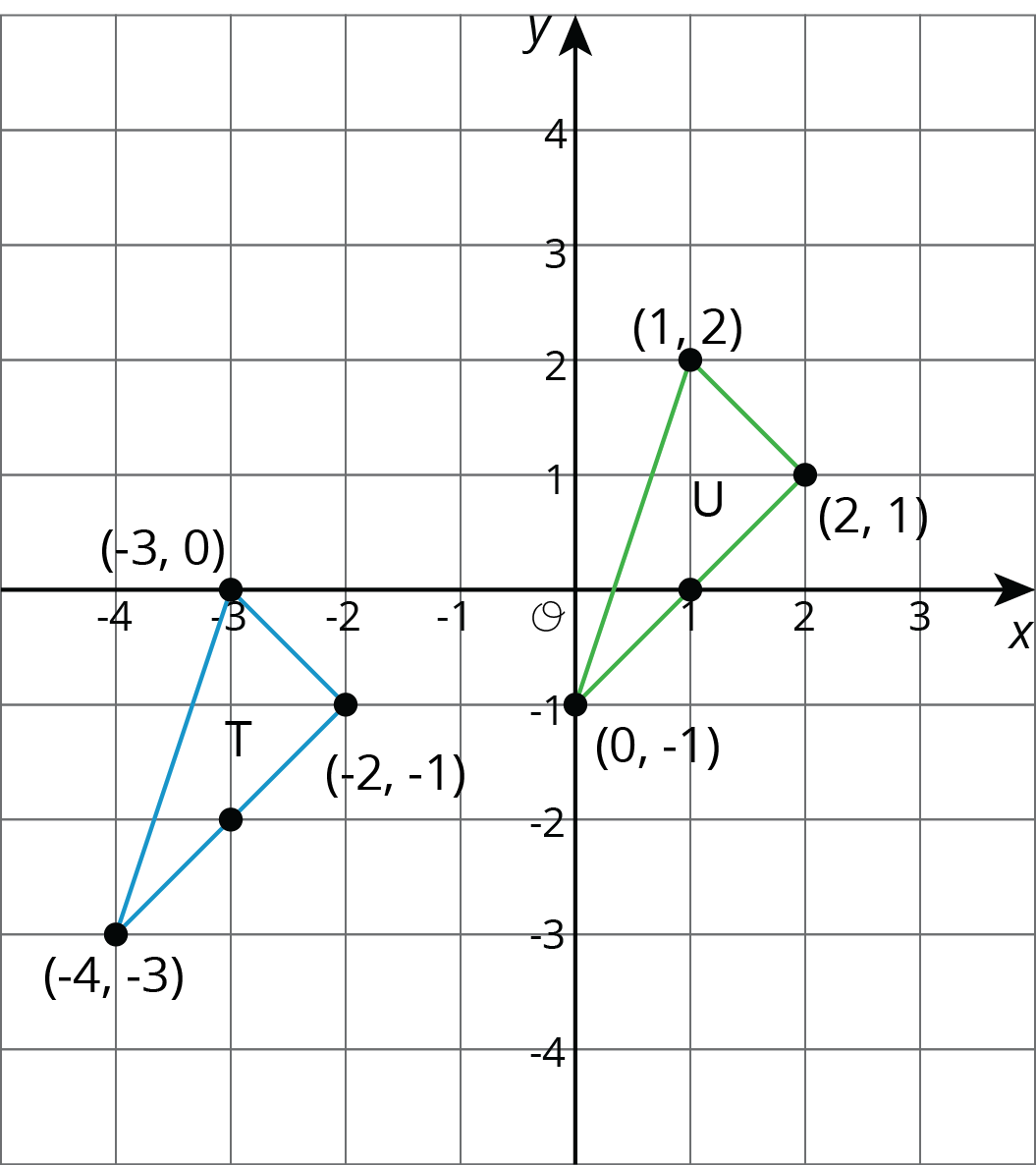
- Translate \((\text-3,0)\) to \((1,2)\).
- Translate \((2,1)\) to \((\text-2,\text-1)\).
- Translate \((\text-4,\text-3)\) to \((0,\text-1)\).
-
Translate \((1,2)\) to \((2,1)\).
Student Response
For access, consult one of our IM Certified Partners.
Anticipated Misconceptions
Students may think that they need more information to determine the translation. Remind them that specifying one point tells you the distance and direction all of the other points move in a translation.
Activity Synthesis
Remind students that once you name a starting point and an ending point, that completely determines a translation because it specifies a distance and direction for all points in the plane. Appealing to their experiences with tracing paper may help. In this case, we might describe that distance and direction by saying “all points go up 2 units and to the right 4 units.” Draw the arrow for the two correct descriptions and a third one not in the list, like this:
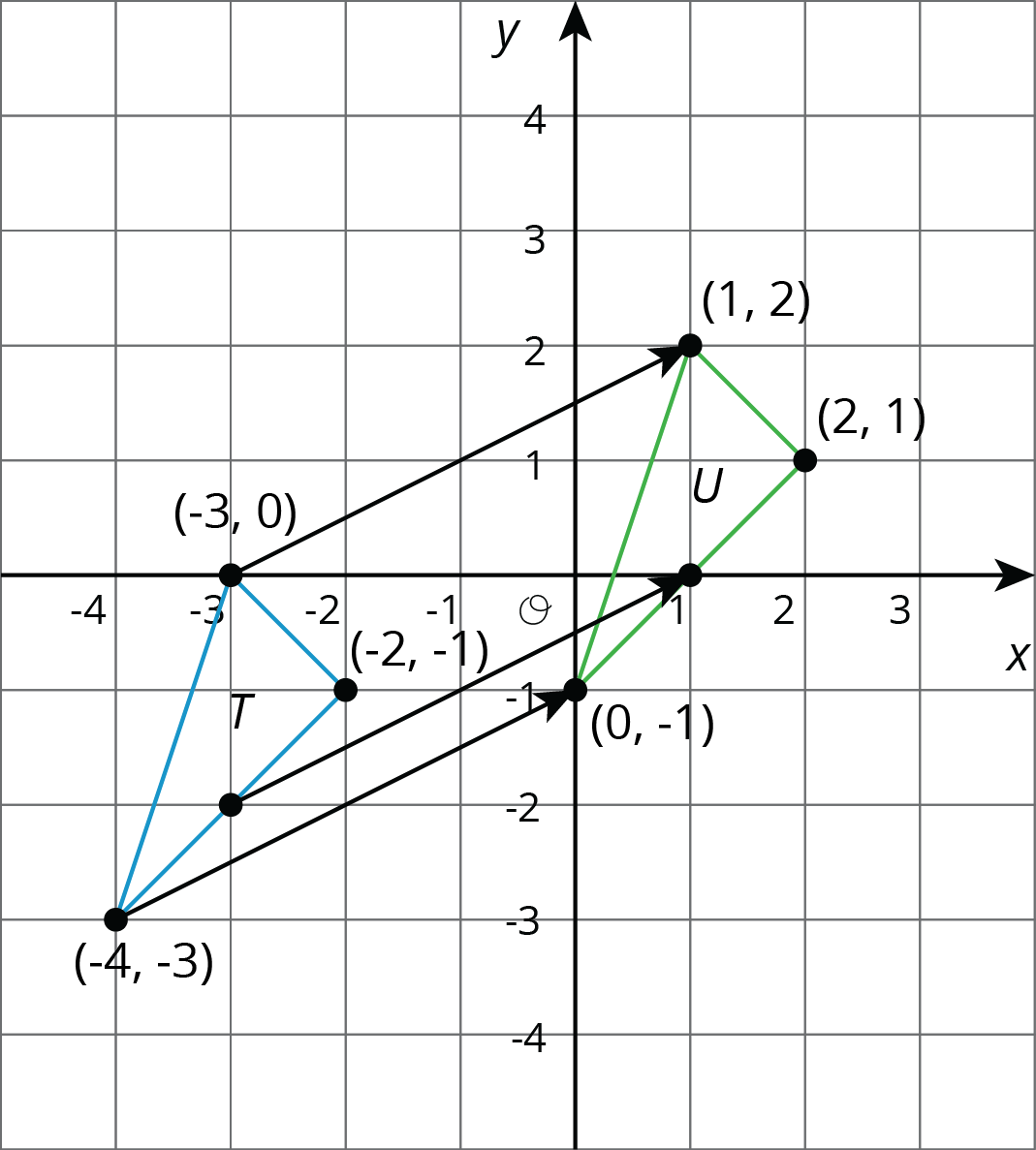
Point out that each arrow does, in fact, go up 2 and 4 to the right.
4.2: Reflecting Points on the Coordinate Plane (15 minutes)
Activity
While the warm-up focuses on studying translations using a coordinate grid, the goal of this activity is for students to work through multiple examples of specific points reflected over the \(x\)-axis and then generalize to describe where a reflection takes any point (MP8). They also consider reflections over the \(y\)-axis with slightly less scaffolding. In the next activity, students will study 90 degree rotations on a coordinate grid, rounding out this preliminary investigation of how transformations work on the coordinate grid.
Watch for students who identify early the pattern for how reflections over the \(x\)-axis or \(y\)-axis influence the coordinates of a point. Make sure that they focus on explaining why the pattern holds as the goal here is to understand reflections better using the coordinate grid. The rule is less important than understanding how it is essential to see the coordinate grid and state the rule.
Launch
Tell students that they will have 5 minutes of quiet think time to work on the activity, and tell them to pause after the second question.
Select 2–3 students to share their strategies for the first 2 questions. You may wish to start with students who are measuring distances of points from the \(x\)-axis or counting the number of squares a point is from the \(x\)-axis and then counting out the same amount to find the reflected point. These strategies work, but overlook the structure of the coordinate plane. To help point out the role of the coordinate plane, select a student who noticed the pattern of changing the sign of the \(y\)-coordinate when reflecting over the \(x\)-axis.
After this initial discussion, give 2–3 minutes of quiet work time for the remaining questions, which ask them to generalize how to reflect a point over the \(y\)-axis.
Classes using the digital version have an applet for graphing and labeling points.
Supports accessibility for: Conceptual processing; Organization
Design Principle(s): Maximize meta-awareness
Student Facing
-
Five points are plotted on the coordinate plane.
-
Using the Pen tool or the Text tool, label each with its coordinates.
-
Using the \(x\)-axis as the line of reflection, plot the image of each point.
- Label the image of each point with its coordinates.
-
Include a label using a letter. For example, the image of point \(A\) should be labeled \(A’\).
-
-
If the point \((13,10)\) were reflected using the \(x\)-axis as the line of reflection, what would be coordinates of the image? What about \((13, \text-20)\)? \((13, 570)\)? Explain how you know.
-
The point \(R\) has coordinates \((3,2)\).
- Without graphing, predict the coordinates of the image of point \(R\) if point \(R\) were reflected using the \(y\)-axis as the line of reflection.
-
Check your answer by finding the image of \(R\) on the graph.
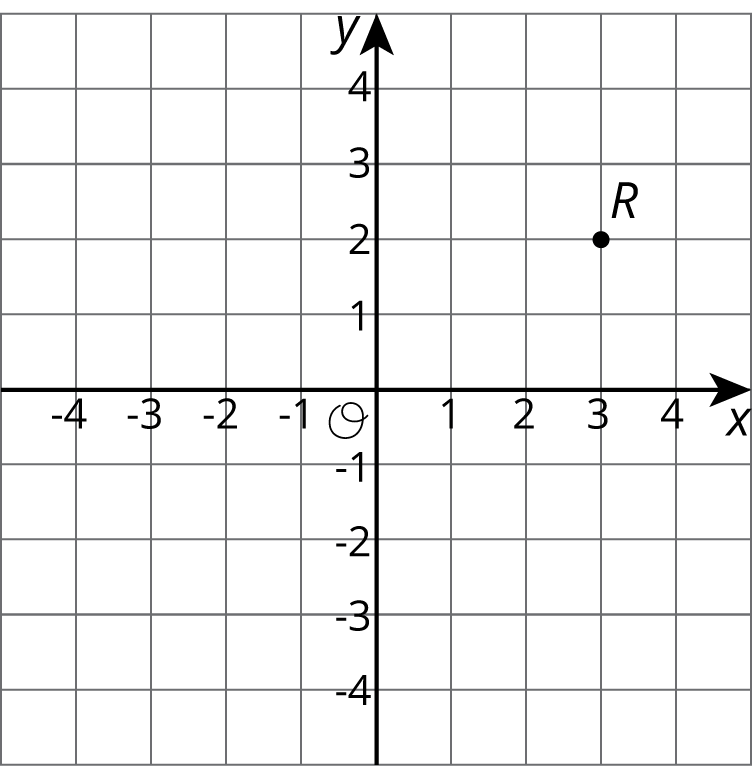
-
Label the image of point \(R\) as \(R’\).
-
What are the coordinates of \(R’\)?
- Suppose you reflect a point using the \(y\)-axis as line of reflection. How would you describe its image?
Student Response
For access, consult one of our IM Certified Partners.
Launch
Tell students that they will have 5 minutes of quiet think time to work on the activity, and tell them to pause after the second question.
Select 2–3 students to share their strategies for the first 2 questions. You may wish to start with students who are measuring distances of points from the \(x\)-axis or counting the number of squares a point is from the \(x\)-axis and then counting out the same amount to find the reflected point. These strategies work, but overlook the structure of the coordinate plane. To help point out the role of the coordinate plane, select a student who noticed the pattern of changing the sign of the \(y\)-coordinate when reflecting over the \(x\)-axis.
After this initial discussion, give 2–3 minutes of quiet work time for the remaining questions, which ask them to generalize how to reflect a point over the \(y\)-axis.
Classes using the digital version have an applet for graphing and labeling points.
Supports accessibility for: Conceptual processing; Organization
Design Principle(s): Maximize meta-awareness
Student Facing
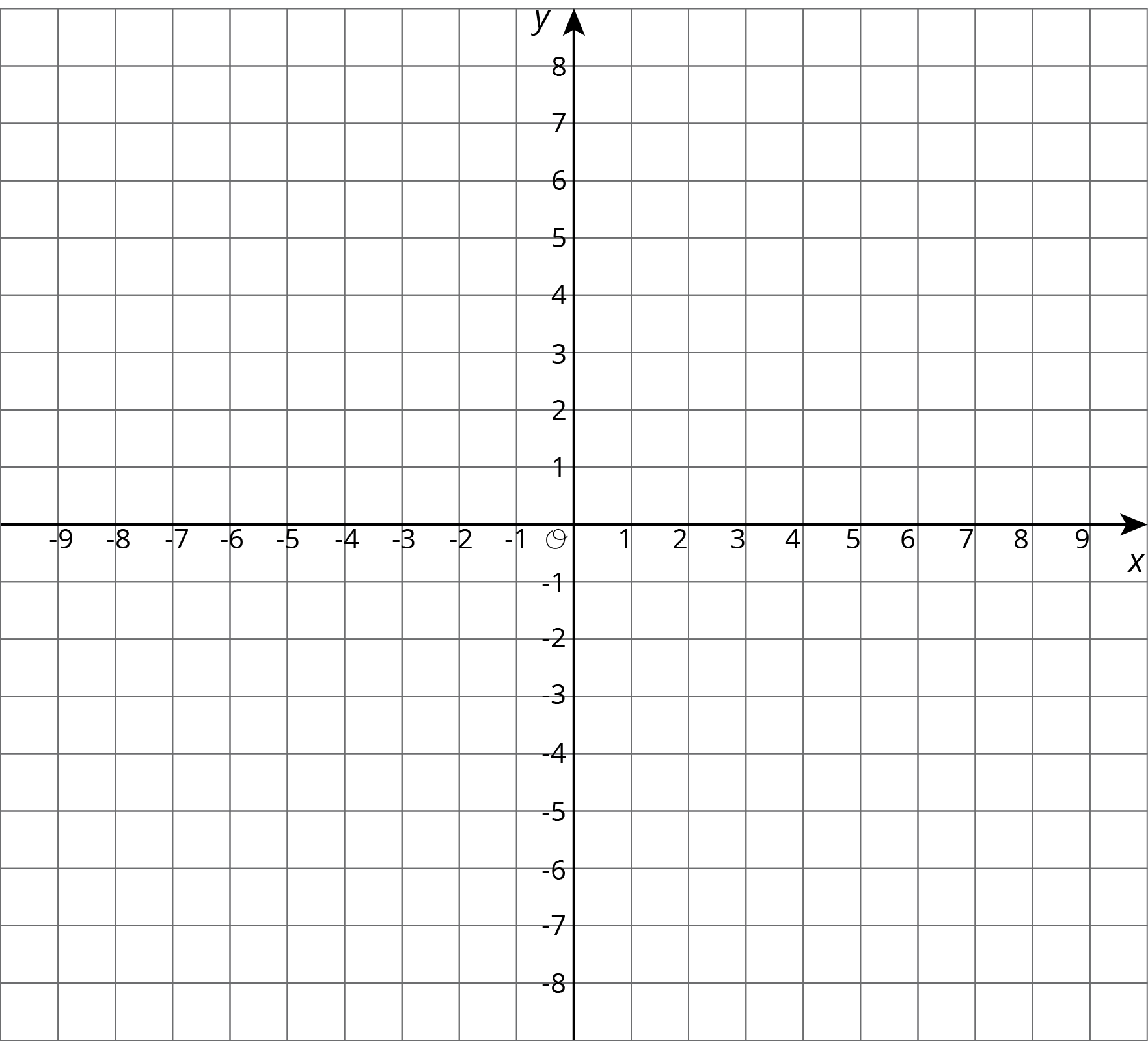
-
Here is a list of points \(\displaystyle \begin{align*} A&= (0.5,4) & B& = (\text-4,5) & C&=(7,\text-2) & D& = (6,0) & E&= (0,\text-3)\\ & \end{align*}\) On the coordinate plane:
- Plot each point and label each with its coordinates.
- Using the \(x\)-axis as the line of reflection, plot the image of each point.
- Label the image of each point with its coordinates.
- Include a label using a letter. For example, the image of point \(A\) should be labeled \(A’\).
-
If the point \((13,10)\) were reflected using the \(x\)-axis as the line of reflection, what would be the coordinates of the image? What about \((13, \text-20)\)? \((13, 570)\)? Explain how you know.
-
The point \(R\) has coordinates \((3,2)\).
- Without graphing, predict the coordinates of the image of point \(R\) if point \(R\) were reflected using the \(y\)-axis as the line of reflection.
- Check your answer by finding the image of \(R\) on the graph.

- Label the image of point \(R\) as \(R’\).
-
What are the coordinates of \(R’\)?
- Suppose you reflect a point using the \(y\)-axis as line of reflection. How would you describe its image?
Student Response
For access, consult one of our IM Certified Partners.
Anticipated Misconceptions
If any students struggle getting started because they are confused about where to plot the points, refer them back to the warm-up activity and practice plotting a few example points with them.
Activity Synthesis
To facilitate discussion, display a blank coordinate grid.

Questions for discussion:
- "When you have a point and an axis of reflection, how do you find the reflection of the point?"
- "How can you use the coordinates of a point to help find the reflection?"
- "Are some points easier to reflect than others? Why?"
- "What patterns have you seen in these reflections of points on the coordinate grid?"
The goal of the activity is not to create a rule that students memorize. The goal is for students to notice the pattern of reflecting over an axis changing the sign of the coordinate (without having to graph). The coordinate grid can sometimes be a powerful tool for understanding and expressing structure and this is true for reflections over both the \(x\)-axis and \(y\)-axis.
4.3: Transformations of a Segment (15 minutes)
Activity
This activity concludes looking at how the different basic transformations (translations, rotations, and reflections) behave when applied to points on a coordinate grid. In general, it is difficult to use coordinates to describe rotations. But when the center of the rotation is \((0,0)\) and the rotation is 90 degrees (clockwise or counterclockwise), there is a straightforward description of rotations using coordinates.
Unlike translations and reflections over the \(x\) or \(y\) axis, it is more difficult to visualize where a 90 degree rotation takes a point. Tracing paper is a helpful tool, as is an index card.
Launch
Demonstrate how to use tracing paper in order to perform a 90 degree rotation. It is helpful to put a small set of perpendicular axes (a + sign) on the piece of tracing paper and place their intersection point at the center of rotation. One of the small axes can be lined up with the segment being rotated and then the rotation is complete when the other small axis lines up with the segment.
An alternative method to perform rotations would be with the corner of an index card, which is part of the geometry toolkit.
Students using the digital version will see the segment being rotated by the computer as they manipulate the sliders.
Student Facing
The applet has instructions for the first 3 questions built into it. Move the slider marked “question” when you are ready to answer the next one. Pause before using the applet to show the transformation described in each question to predict where the new coordinates will be.
Apply each of the following transformations to segment \(AB\). Use the Pen tool to record the coordinates.
-
Rotate segment \(AB\) 90 degrees counterclockwise around center \(B\) by moving the slider marked 0 degrees. The image of \(A\) is named \(C\). What are the coordinates of \(C\)?
-
Rotate segment \(AB\) 90 degrees counterclockwise around center \(A\) by moving the slider marked 0 degrees. The image of \(B\) is named \(D\). What are the coordinates of \(D\)?
-
Rotate segment \(AB\) 90 degrees clockwise around \((0,0)\) by moving the slider marked 0 degrees. The image of \(A\) is named \(E\) and the image of \(B\) is named \(F\). What are the coordinates of \(E\) and \(F\)?
-
Compare the two 90-degree counterclockwise rotations of segment \(AB\). What is the same about the images of these rotations? What is different?
Student Response
For access, consult one of our IM Certified Partners.
Launch
Demonstrate how to use tracing paper in order to perform a 90 degree rotation. It is helpful to put a small set of perpendicular axes (a + sign) on the piece of tracing paper and place their intersection point at the center of rotation. One of the small axes can be lined up with the segment being rotated and then the rotation is complete when the other small axis lines up with the segment.
An alternative method to perform rotations would be with the corner of an index card, which is part of the geometry toolkit.
Students using the digital version will see the segment being rotated by the computer as they manipulate the sliders.
Student Facing
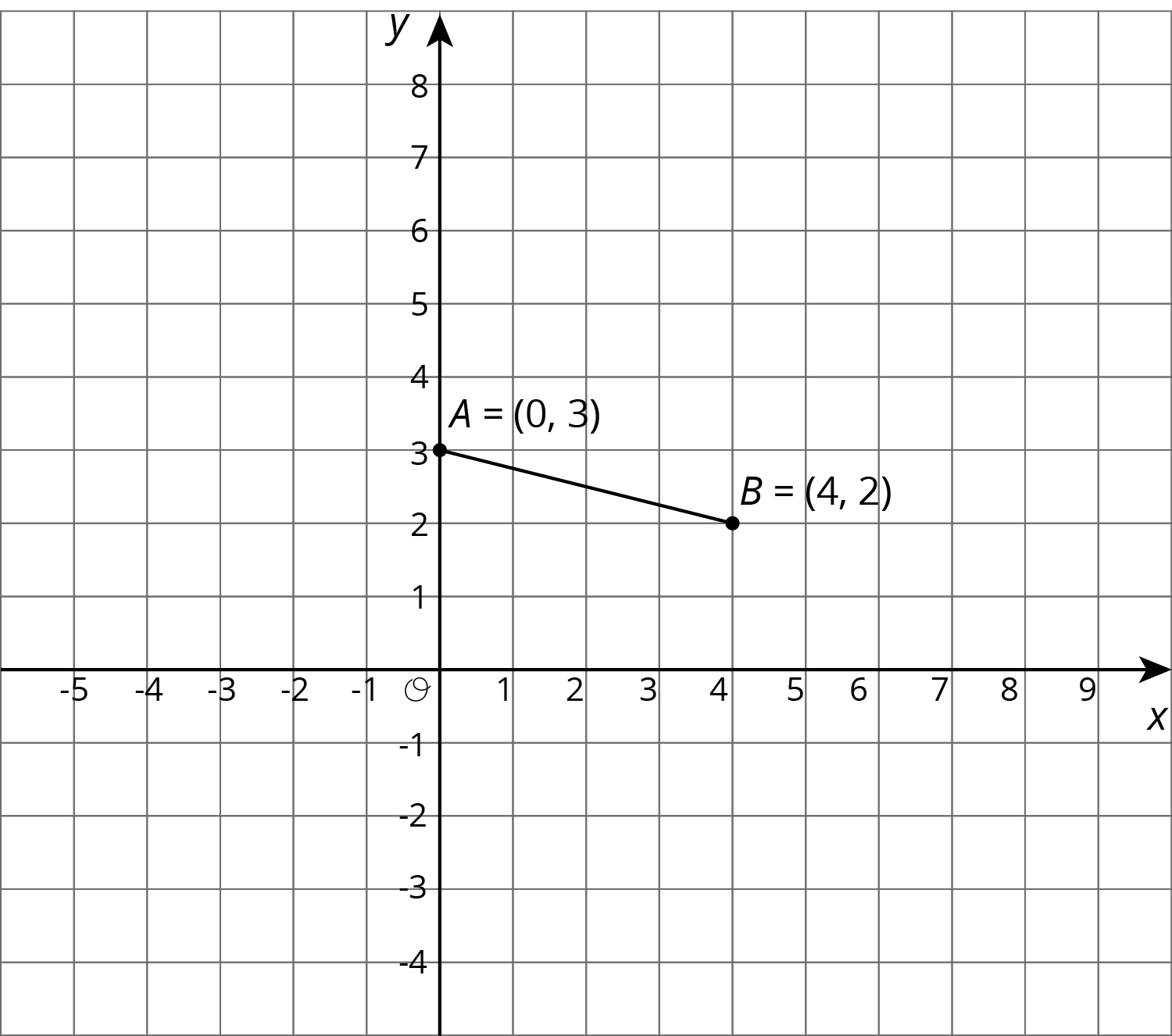
Apply each of the following transformations to segment \(AB\).
-
Rotate segment \(AB\) 90 degrees counterclockwise around center \(B\). Label the image of \(A\) as \(C\). What are the coordinates of \(C\)?
- Rotate segment \(AB\) 90 degrees counterclockwise around center \(A\). Label the image of \(B\) as \(D\). What are the coordinates of \(D\)?
-
Rotate segment \(AB\) 90 degrees clockwise around \((0,0)\). Label the image of \(A\) as \(E\) and the image of \(B\) as \(F\). What are the coordinates of \(E\) and \(F\)?
-
Compare the two 90-degree counterclockwise rotations of segment \(AB\). What is the same about the images of these rotations? What is different?
Student Response
For access, consult one of our IM Certified Partners.
Student Facing
Are you ready for more?
Suppose \(EF\) and \(GH\) are line segments of the same length. Describe a sequence of transformations that moves \(EF\) to \(GH\).
Student Response
For access, consult one of our IM Certified Partners.
Activity Synthesis
Ask students to describe or demonstrate how they found the rotations of segment \(AB\). Make sure to highlight these strategies:
- Using tracing paper to enact a rotation through a 90 degree angle.
- Using an index card: Place the corner of the card at the center of rotation, align one side with the point to be rotated, and find the location of the rotated point along an adjacent side of the card. (Each point's distance from the corner needs to be equal.)
- Using the structure of the coordinate grid: All grid lines are perpendicular, so a 90 degree rotation with center at the intersection of two grid lines will take horizontal grid lines to vertical grid lines and vertical grid lines to horizontal grid lines.
The third strategy should only be highlighted if students notice or use this in order to execute the rotation, with or without tracing paper. This last method is the most accurate because it does not require any technology in order to execute, relying instead on the structure of the coordinate grid.
If some students notice that the three rotations of segment \(AB\) are all parallel, this should also be highlighted.
Supports accessibility for: Language; Social-emotional skills; Attention
Design Principle(s): Support sense-making; Optimize output for (comparison)
Lesson Synthesis
Lesson Synthesis
By this point, students should start to feel confident applying translations, reflections over either axis, and rotations of 90 degrees clockwise or counterclockwise to a point or shape in the coordinate plane.
To highlight working on the coordinate plane when doing transformations, ask:
- "What are some advantages to knowing the coordinates of points when you are doing transformations?"
- "What changes did we see when reflecting points over the \(x\)-axis? \(y\)-axis?"
- "How do you perform a 90 degree clockwise rotation of a point with center \((0,0)\)?"
Time permitting, ask students to apply a few transformations to a point. For example, where does \((1,2)\) go when
- reflected over the \(x\)-axis? \((1,\text-2)\)
- reflected over the \(y\)-axis? \((\text-1,2)\)
- rotated 90 degrees clockwise with center \((0,0)\)? \((2,\text-1)\)
4.4: Cool-down - Rotation or Reflection (5 minutes)
Cool-Down
For access, consult one of our IM Certified Partners.
Student Lesson Summary
Student Facing
We can use coordinates to describe points and find patterns in the coordinates of transformed points.
We can describe a translation by expressing it as a sequence of horizontal and vertical translations. For example, segment \(AB\) is translated right 3 and down 2.
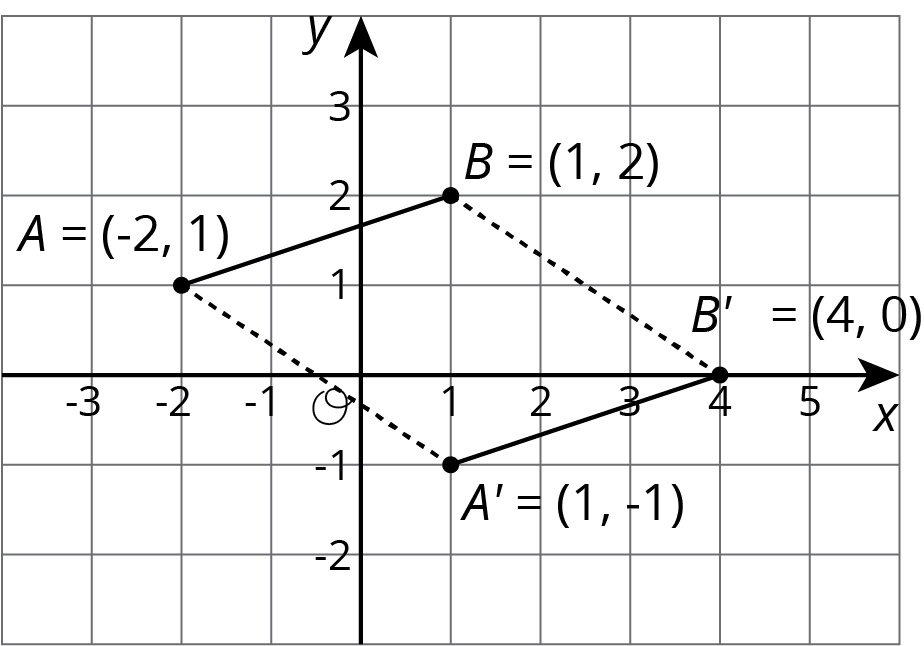
Reflecting a point across an axis changes the sign of one coordinate. For example, reflecting the point \(A\) whose coordinates are \((2,\text-1)\) across the \(x\)-axis changes the sign of the \(y\)-coordinate, making its image the point \(A’\) whose coordinates are \((2,1)\). Reflecting the point \(A\) across the \(y\)-axis changes the sign of the \(x\)-coordinate, making the image the point \(A’’\) whose coordinates are \((\text-2,\text-1)\).
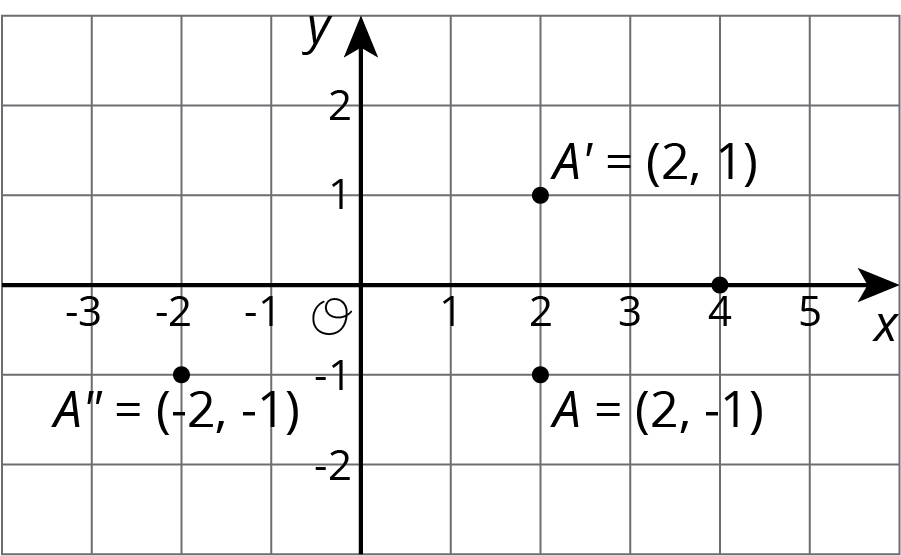
Reflections across other lines are more complex to describe.
We don’t have the tools yet to describe rotations in terms of coordinates in general. Here is an example of a \(90^\circ\) rotation with center \((0,0)\) in a counterclockwise direction.

Point \(A\) has coordinates \((0,0)\). Segment \(AB\) was rotated \(90^\circ\) counterclockwise around \(A\). Point \(B\) with coordinates \((2,3)\) rotates to point \(B’\) whose coordinates are \((\text-3,2)\).